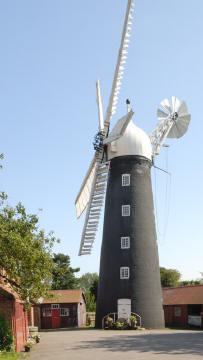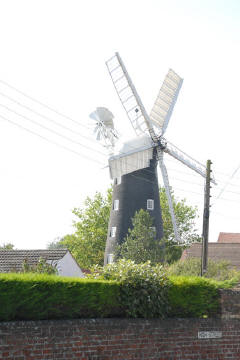Dobson's Windmill
| Burgh le Marsh, Lincolnshire
The mill was built by Sam Oxley of Alford in
about 1813, he also built the Alford windmill. It has five storeys and has
unusual left-handed sails which means the sails rotate clockwise. It
contains much of its original equipment.
The mill is named after Frank Dobson who worked
on the mill until 1964.
The mill should be working on open days wind
permitting. There is a milling museum which includes a Blackstone Diesel engine.
Some confusion as to what was here
earlier
It is shown on an Estate map of 1819 as having
four sails. These are said to have been common sails operated from a stage but
some think it has always had patent sails. The stage is now missing but the
filled-in putlog holes can be made out at second floor level, where the two door
openings have been partly filled in and converted to windows. Some suggest that
as a stage only relied on the putlogs for support it cannot have been wide
enough to reef common sails from. They think it originally had five sails
as it does at present, like Alford Mill which was also erected in 1813 by Oxley.
|

 Click Image to see a larger version
Click Image to see a larger version |
How it works
The five patent sails drive through a composite
brake wheel with iron hub, spokes and teeth and a wooden rim. The brake band is
also of iron. The wallower is of iron with mortised wooden cogs, an unusual type
in the County. The sackhoist is driven from the underside of the wallower and as
is often found uses an endless chain which saves having to lower the chain after
each sack is raised.
There are two bin floors, both divided up by partitions and the stones are on
the second floor. The two pairs of greys and one pair of French are driven in
the usual manner by an iron great spur wheel, mortice stone nuts and an iron
upright shaft. A fourth 'nut' engages with the spur wheel and formerly took the
drive from the auxiliary oil engine. By putting the wallower out of gear it was
possible to then drive the 'wind' stones by engine if desired.
The first floor, in addition to containing the wind-mill tentering gear,
governor and spouts, has a pair of grey stones directly underdriven from the
engine by way of bevel gears. The ground floor contains more engine driven
machinery consisting of a Hunt Corn Crushing Mill (or roller mill), a mixer by Thompsons of Alford (for making up animal feeds) and an elevator for moving
stock around when the wind-powered hoist is not in use.
It has an engine that takes over at least some
roles when there is not enough wind.
When we visited
When we visited we found the best position to take a photograph was just
inside the entrance, picture right. We walked around other streets, and
although you can see it from most directions without difficulty there are
low level obstacles, as in the picture below. Because of the angle you are
shooting up at, the mill tends to lean back, the image on the right has had
its perspective corrected in Photoshop.
War time memory of this mill in WW2
By
Marjorie McClory, on WW2 peoples war (BBC)

© Copyright of content
contributed to this Archive rests with the author. Find out
how you can use this.

I was 9 years old when war broke out. My
father, Frank Dobson owned the windmill and bakehouse in Burgh-le-Marsh,
Lincolnshire during the war. The Sherwood Forresters, Kings Shropshire Light
Infantry (or KSLI – Kings Silly Little Idiots), Duke of Wellingtons
commandeered the windmill yard and sheds for the various transport vehicles
such as the Brenn Gun carriers, motorbikes etc. My mother invited some of
the troops in for baths and cups of tea, a luxury for them at the time to
make them feel more at home.
The miller used to get annoyed with the
Brenn Gun drivers because their caterpillar tracks used to churn up the
asphalt surface.
Because there were so many troops stationed
here, getting in and out of the village was difficult. You had to show your
identity cards before you were allowed in.
When the troops came back from Dunkirk,
they had only the uniforms they stood up in, no vehicles or guns came back
with them. Part of the cattle market was turned into a field cookhouse. |

 |
Further information Grid
Planning Grid
|
Location: |
Dobson's Windmill, Burgh le Marsh, Lincolnshire |
|
Grid Reference: |
TF 504649 |
|
Getting there: |
High
Street, Burgh-le-Marsh, about 5 miles west of Skegness, on A158. |
|
Access: |
|
|
Parking: |
|
|
Facilities: |
|
|
Things To Do,
See and Photograph: |
|
|
What to take: |
|
|
Nature highlights: |
|
|
Address: |
|
|
Postcode: |
|
|
Telephone: |
Curator,
John Clarke
Tel
- 01754 810324 |
|
Opening times: |
April to
September, Sundays, 14.00 – 17.00
Parties by arrangement.
plus
one weekday ?
National Mills Weekend
Sunday,
14.00 – 17.00. |
|
Charges: |
Admission: donation |
|
Photo Restrictions: |
|
|
Other Restrictions: |
|
|
Special Needs Access: |
|
|
Special Needs Facilities: |
|
|
Children Facilities: |
|
|
Dogs Allowed: |
|
|
CIN Page Ref: |
Dobsons |
Date Updated: 05/2008 |
Please let us know any other information that we
can add to the Further information and Planning Grids or page and any errors that you discover. Before making a long trip to any location it is always
wise to double check the current information, websites like magazines may be
correct at the time the information is written, but things change and it is of
course impossible to double check all entries on a regular basis. If you have
any good photographs that you feel would improve the illustration of this page
then please let us have copies. In referring to this page it is helpful if you
quote the CIN Page Ref at the bottom of the Planning Grid above. To print the
planning grid select it then right click and print the selected area.
Please submit information on locations you discover so
that this system continues to grow.
|